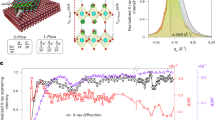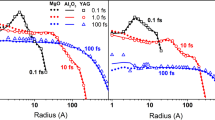Abstract
We consider a model based on the thermal spike concept for an explanation of latent track formation in YBa2Cu3O7−x single crystal. The model demonstrates some interesting peculiarities such as “electronic quenching” and the existence of bifurcation points. Arguments for why the energy spent on damage creation in the track should be equal to the melting heat and why the so-called “epitaxial regrowth” is impossible are given.
Similar content being viewed by others
References
M. Konczykowski et al., Phys. Rev. B 44, 7167 (1991).
V. Hardy et al., Nucl. Instrum. Methods Phys. Res. B 54, 472 (1991).
L. Civale et al., Phys. Rev. Lett. 67, 648 (1991).
I. M. Lifshits, M. I. Kaganov, and L. V. Tanatarov, J. Nucl. Energy, Part A 12, 69 (1960).
R. L. Fleischer, P. B. Price, and R. M. Walker, Nuclear Tracks in Solids: Principles and Applications (Univ. California Press, Berkeley, Calif., 1979; Energoizdat, Moscow, 1981).
E. Dartyge, Phys. Rev. B 32, 5429 (1985).
K. Tanimura and N. Itoh, Phys. Rev. B 46, 14362 (1992).
Zhu Yimei et al., Phys. Rev. B 48, 6436 (1993).
Zhu Yimei, Z. X. Cai, and D. O. Welch, Philos. Mag. A 73, 1 (1996).
G. Szenes, Phys. Rev. B 54, 12458 (1996).
I. N. Goncharov, B. F. Kostenko, and V. P. Philinova, Phys. Lett. A 288, 111 (2001).
M. Toulemonde, C. Dufour, and E. Paumier, Phys. Rev. B 46, 14362 (1992).
L. T. Chadderton and I. M. Torrens, Fission Damage in Crystals (Methuen, London, 1969).
A. Meftah et al., Phys. Rev. B 49, 12457 (1994).
S. D. Brorson et al., Solid State Commun. 74, 1305 (1990).
I. I. Vengrus et al., Piss’ma Zh. Eksp. Teor. Fiz. 62, 739 (1995) [JETP Lett. 62, 758 (1995)].
P. Allen et al., Phys. Rev. B 49, 9073 (1994).
M. P. R. Waligorski, R. N. Hamm, and R. Katz, Nucl. Tracks Radiat. Meas. 1, 309 (1986).
V. S. Barashenkov, Rus. Chem. High Energies 28, 229 (1994).
A. Meftah et al., Phys. Rev. B 48, 920 (1993).
J. F. Ziegler, SRIM 2003, Version 2003.26, www.srimor.
E. A. Ayrjan, A. V. Fedorov, and B. F. Kostenko, Part. Nucl., Lett. 99(2), 42 (2000).
H. Krakauer, W. E. Pickett, and R. E. Cohen, J. Supercond. 1, 111 (1998).
M. F. Crommil and A. Zettle, Phys. Rev. B 41, 10978 (1990).
J. L. Cohn et al., Physical Properties of High Temperature Superconductors III, Ed. by D. M. Ginsberg (World Sci., Singapore, 1992).
Yu. V. Martynenko and Yu. N. Yavlinski, Dokl. Akad. Nauk SSSR 268, 88 (1983) [Sov. Phys. Dokl. 28, 391 (1983)]; Preprint IAE-4084/11 (Moscow, 1985).
G. Sciwietz et al., Nucl. Instrum. Methods Phys. Res. B 164–165, 354 (2000).
Lusternik V. E. et al., Rus. Supercond.: Phys., Chem., Eng. 3, 2037 (1990).
H. Teichler, Phys. Rev. B 59, 8473 (1999).
G. M. Mironova, Mater. Sci. Forum 133–136, 847 (1993).
K. Salama and D. F. Lee, Supercond. Sci. Technol. 7, 177 (1994).
Y. Idemoto and K. Fueki, Jpn. J. Appl. Phys. 29, 2729 (1990).
S. Wermbter and L. Tewordt, Physica C 183, 365 (1991).
S. D. Peaur, J. L. Cohn, and C. Uher, Phys. Rev. B 43, 8721 (1991).
D. R. Atthey, J. Inst. Maths. Applics. 13, 53 (1974).
A. M. Meirmanov, The Stefan Problem (Walter de Gruyter, Berlin 1992).
B. F. Kostenko, J. Pribis, and I. V. Puzynin, mathph/0302044; J. Comput. Methods Sci. Eng. (in press).
F. Faupel et al., Rev. Mod. Phys. 75, 237 (2003).
M. Toulemonde, S. Bouffard, and E. Studer, Nucl. Instrum. Methods Phys. Res. B 91, 108 (1994).
A. A. Samarskii, Difference Schemes Theory (Nauka, Moscow, 1983) [in Russian].
B. F. Kostenko and J. Pribish, “Mathematical Modeling of Track Formation in High Temperature Superconductors,” Bull. Peopless’ Friendship Univ. Russ., Ser. Appl. Comput. Math. 4(1), 75 (2005).
Author information
Authors and Affiliations
Additional information
The text was submitted by the authors in English.
Rights and permissions
About this article
Cite this article
Kostenko, B.F., Pribiš, J. & Goncharov, I.N. Thermal spike model of track formation in YBa2Cu3O7−x . Phys. Part. Nuclei Lett. 3, 18–26 (2006). https://doi.org/10.1134/S1547477106010031
Received:
Issue Date:
DOI: https://doi.org/10.1134/S1547477106010031




